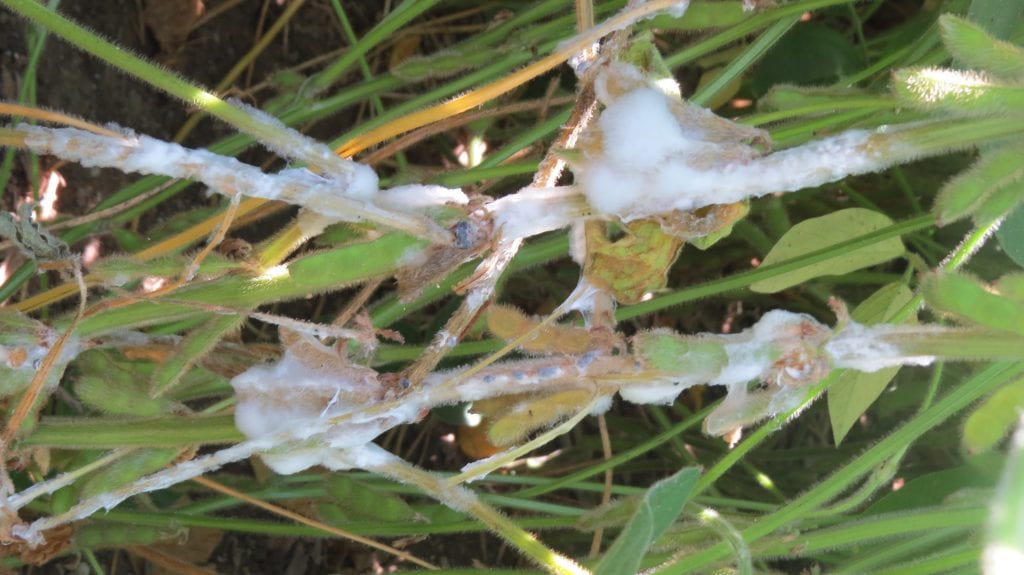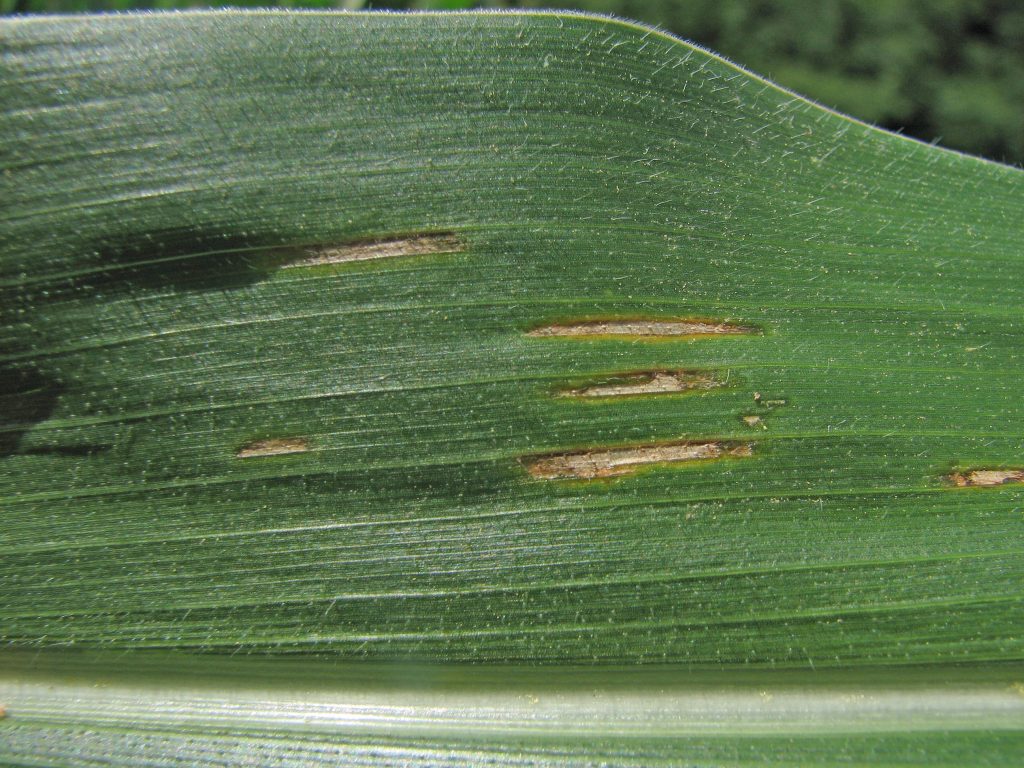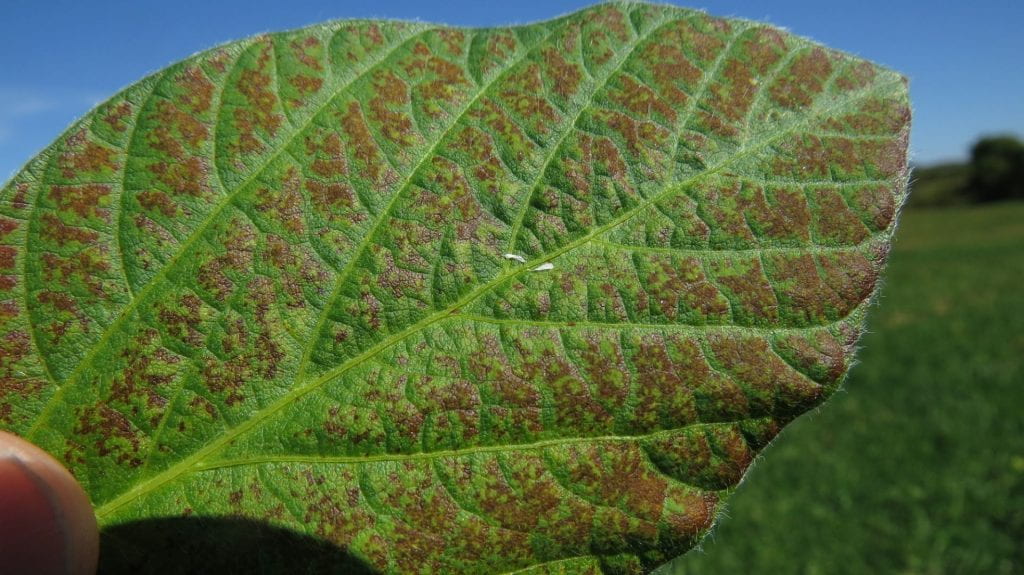Volume 18, Number 16
Contents
View from the Field
Josh Putman (CCE SW NYS Dairy, Livestock & Field Crops Program) states that he is finding white mold in soybeans in Cattaraugus and Chautauqua counties.
Jaime Cummings (NYS IPM) Reports finding downy mildew, Japan beetles, and Fusarium wilt is soybeans. She also found gray leaf spot and corn rootworm beetles in Tompkins County.
Ken Wise (NYS IPM) reports finding downy mildew and cercospora leaf spot soybeans in Dutchess County. He also was finding a fair amount of gray leaf spot in field corn.
Mike Stanyard (CCE NW Dairy, Livestock & Field Crops Team) is finding red-headed flea beetle in soybeans and hemp. He reports finding alfalfa looper at high populations in 4th cutting alfalfa. Mike also reports finding true armyworm.
Dr. Gary Bergstrom (Cornell University Field Crops Pathologist-Professor) confirmed the presence of septoria leaf spot in the Hudson Valley. He also reports the occurrence of several soybean soilborne diseases across the state.
Weather Outlook – August 15, 2019
Jessica Spaccio
NOAA Northeast Regional Climate Center, Cornell University
Last week temperatures ranged within 2 degrees of normal. Precipitation has ranged from a quarter inch to 3 inches. Base 50 growing degree-days ranged from 80 to 160.
An active weather pattern expected for the week. Temperatures and humidity will increase for the end of the weekend into next week.
Today a week frontal system will bring a chance for showers and thunderstorms, a few strong storms could develop with gusty winds, hail, & brief downpours; northern areas of the state will stay dry and sunny. Temperatures will be in the 70s to near 80. Overnight lows will be in the mid 50s to mid 60s with overnight showers and thunderstorms.
Friday scattered showers and thunderstorms will move through, with increased humidity and temperatures in the mid 70s to low 80s. Overnight temperatures will be in the mid 50s to mid 60s.
Saturday temperatures will be in the low to mid 80s with afternoon and evening showers and thunderstorms. Overnight temperatures will be in the upper 50s to mid 60s.
Sunday highs will be in the 80s to near 90 with increased chances for shows and thunderstorms with gusty winds. Overnight temperatures will be in the 60s.
Monday will be warm and humid with temperatures in the 80s to near 90. Showers and thunderstorms are possible. Overnight temperatures will be in the 60s.
Tuesday highs will be in the 80s. Overnight temperatures will be in the 60s.
Wednesday highs will be in the low to mid 80s. A cold front is expected to bring cooler temperatures and lower humidity. Overnight temperatures will be in the 60s.
The seven-day precipitation amounts will range from a quarter inch to one and a quarter inches.
The 8-14 day outlook (August 22-28) favors above-normal temperatures for the state, with high probability. The outlook slightly favors below-normal precipitation for northern and eastern areas and near-normal precipitation for the rest of the state.
Maps of 8-14 day outlooks:
http://www.cpc.ncep.noaa.gov/products/predictions/814day/index.php
National Weather Service watch/warnings map:
US Drought Monitor
http://droughtmonitor.unl.edu/Home.aspx
Drought Impact Reporter:
https://droughtreporter.unl.edu/map/
CLIMOD2 (NRCC data interface):
http://climodtest.nrcc.cornell.edu
Planting Winter Small Grains? What are the Pest Issues?
Growing cereal grains is on the increase across New York. Many of the winter grains will be planted in the near future. Many producers are planting small grain cover crops this fall. Some will be planting winter wheat, winter rye, winter triticale and winter malting barley for grain and straw. Sometimes we forget that there are several diseases and insect pest issues with planting winter small grains too early. Here is a list of items to consider when planting.
- Do not plant cereal grains in the same field that had previously been a small grain. Rotation helps control many diseases like: scald, powdery mildew, Stagonospora nodorum blotch, glume blotch and more.
- Select a cultivar that is adapted for your region. Remember to select one that has resistant to many of the diseases in the area. The diseases you want to think wheat spindle streak mosaic virus, soil borne mosaic virus, barley yellow dwarf virus, powdery mildew, leaf & stem rust, spot blotch, net blotch and more.
- Follow the Hessian Fly Free Date: Make all small grains (cover crop or grain) are planted AFTER the Hessian Fly Free Date! Why? Hessian fly is a pest of small grains. The Hessian Fly Free Date is the point that Hessian fly is not active in the fall. The Hessian Fly Free Date indicates when aphids will not be active in the fields. Aphids alone are not a problem but they can transmit barley yellow dwarf disease to the plants.
- ALWAYS use certified seed when planting. Certified seed is free from weeds and other diseases.
- If planting conventional small grains it is important to use a fungicide on the seed at planting. This will help protect from soil borne fungal diseases.
- Good integrated crop management is also important. Soil health, fertility, tillage practices, proper seed bed preparation, planting depth make for a healthy plant that can withstand more pest pressure.
Western Bean Cutworm Data: 8/20/19
Clipboard Checklist
Keith Waldron, NYS IPM
General
*Walk fields to check general field condition, weed, vertebrate and other issues
*Watch for crop maturity, stand assessments, weed escapes, nutrient deficiencies, lodging issues
*Update crop records and field history
Alfalfa:
*Evaluate established legume stands for approximate days until harvest
*Monitor potato leafhopper, foliar, systemic and crown rot diseases.
*Monitor new seedings for potato leafhopper, pythium blight, phytopthora root rot.
Small Grains:
*Monitor grain fields for growth stage, disease and lodging issues, grain maturity, harvest timing
*Record diseases present, location and types of weed escapes
* Prepare for planting winter small grains after the Hessian Fly Free Date.
Corn:
*Monitor for mid-season corn pests including European corn borer, corn rootworm, western bean cutworm, slugs, foliar diseases such as northern corn leaf blight and gray leaf spot, weed issues, nutrient deficiencies, vertebrate damage.
Soybeans:
*Monitor for growth stage, soybean aphid, defoliators, foliar diseases, white mold, weed issues, vertebrate damage
Pastures:
*Check water sources, mend fences as needed.
*Check crop growth, clip pastures between grazing as needed
*Monitor for invasive species, plants harmful to livestock
*Review/Plan rotations
Storage:
* Check stored grain bins for temperature, moisture and signs of mold and insects. Aerate, core, transfer grain or treat as necessary
* Clean and disinfect empty storage bins in preparation for grain harvest
*Check forage allocation and anticipate feed program adjustments as forages from previous year are used up
*Mow around storage bins and facility to minimize pest hiding places
Dairy Cattle Barn Fly Management:
*Monitor animals and barn area for house fly, stable fly and other pest management needs including presence of rodents and birds.
*Check facilities for favorable fly breeding conditions: (organic matter + moisture): leaks in watering systems, roof gutters for leaks and potential overspill, drainage,
*Sanitation, sanitation, sanitation – clean animal resting areas, feed troughs, minimize source of moist organic matter i.e. fly breeding areas in barn and in adjacent animal loafing yard
* Continue fly monitoring: install “3X5″ index card fly speck monitoring cards throughout barn
*Use, replenish, replace fly management materials: sticky fly tapes/ribbons, insecticide baits, natural enemies (parasitoids), fly population monitoring (3 x 5) spot cards
*Consider purchase and release of Muscidifurax raptor and/or M. raptorellus natural enemies of house and stable fly pupae.
Dairy Cattle on Pasture:
*Monitor animals for presence of face flies, horn flies and stable flies. Action guidelines: face flies (average 10 per animal face), horn flies (average 50 / dairy per animal side, 200 / beef cattle per animal side), stable flies average 10 per animal (all four legs)
*Check feed bunk / water source locations for signs of stable fly breeding (moist undisturbed organic matter – spilled feed, round bales, etc.), minimize source of moist organic matter i.e. fly breeding areas in barn and in adjacent animal exercise yard.
*Check pasture for forage quality / quantity, rotate as appropriate
*Check pasture for vegetation poisonous to livestock
*Consider use of pasture fly traps to help reduce deer, horse and stable fly populations






